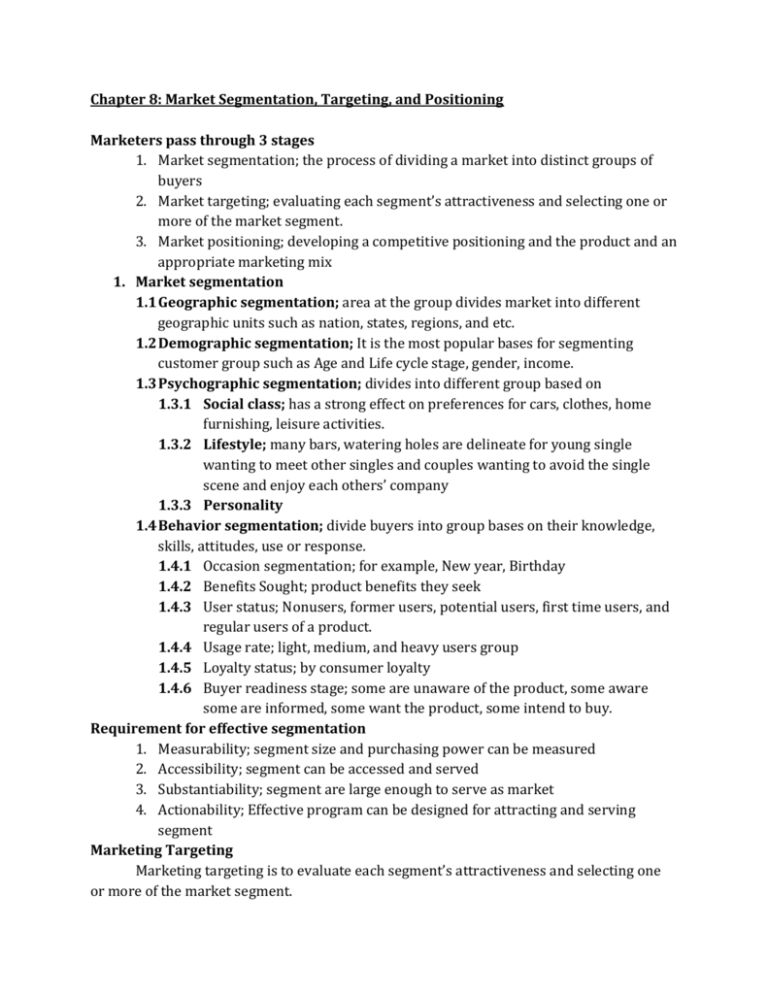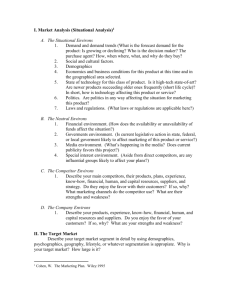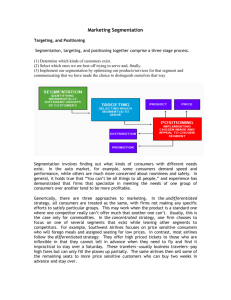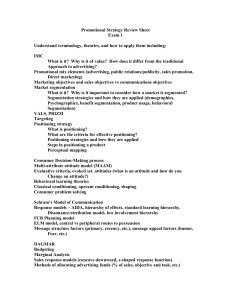Chapter 8
advertisement

Chapter 8: Market Segmentation, Targeting, and Positioning Marketers pass through 3 stages 1. Market segmentation; the process of dividing a market into distinct groups of buyers 2. Market targeting; evaluating each segment’s attractiveness and selecting one or more of the market segment. 3. Market positioning; developing a competitive positioning and the product and an appropriate marketing mix 1. Market segmentation 1.1 Geographic segmentation; area at the group divides market into different geographic units such as nation, states, regions, and etc. 1.2 Demographic segmentation; It is the most popular bases for segmenting customer group such as Age and Life cycle stage, gender, income. 1.3 Psychographic segmentation; divides into different group based on 1.3.1 Social class; has a strong effect on preferences for cars, clothes, home furnishing, leisure activities. 1.3.2 Lifestyle; many bars, watering holes are delineate for young single wanting to meet other singles and couples wanting to avoid the single scene and enjoy each others’ company 1.3.3 Personality 1.4 Behavior segmentation; divide buyers into group bases on their knowledge, skills, attitudes, use or response. 1.4.1 Occasion segmentation; for example, New year, Birthday 1.4.2 Benefits Sought; product benefits they seek 1.4.3 User status; Nonusers, former users, potential users, first time users, and regular users of a product. 1.4.4 Usage rate; light, medium, and heavy users group 1.4.5 Loyalty status; by consumer loyalty 1.4.6 Buyer readiness stage; some are unaware of the product, some aware some are informed, some want the product, some intend to buy. Requirement for effective segmentation 1. Measurability; segment size and purchasing power can be measured 2. Accessibility; segment can be accessed and served 3. Substantiability; segment are large enough to serve as market 4. Actionability; Effective program can be designed for attracting and serving segment Marketing Targeting Marketing targeting is to evaluate each segment’s attractiveness and selecting one or more of the market segment. Evaluating market segment 1. Segment size and growth 2. Segment structural attractiveness for example, A segment is less attractive if it already contains many strong and aggressive competitors. 3. Company objectives and resources Selecting market segment (3 market coverage strategies) 1. Undifferentiated Marketing strategy; a company ignores market segmentation difference and goes after the entire market with one market offer. 2. Differentiated marketing strategy; a company targets several market segments and designs separate offers for each. 3. Concentrated marketing strategy; 5 star hotel, limited resources Choosing a market coverage strategy 1. The company resources; when resources are limited, concentrated marketing makes the most scene. 2. The degree of product homogeneity; undifferentiated marketing is more suited for homogeneous products 3. Market homogeneity 4. Competitors strategies Positioning for competitive advantage; Product’s position is the way the product is defined by consumers on important attributes-the place the product occupies in consumers’ minds relative to competing products. Marketers’ must-plan positions to give their target the best. Product Differentiation 1. Physical attributes; the physical environment offers something that the competitors cannot make. 2. Service differentiates; providing services that will benefit its target market, a company can achieve. 3. Personnel differentiate; Company can gain a strong competitive advice through hiring and training better people than their competitors. 4. Location; by looking for the benefits created by their location and use these benefits to different themselves from their market. 5. Image differentiates; a company or brand image Selecting the right competitive advantages 1. How many differences? - Under positioning or failing to position the company at all - Over positioning or giving buyers too narrow a picture of the company - Confused positioning leaving buyer with a confused image of a company 2. Which difference? - Not all differences are meaningful or worthwhile, and not every difference makes a good differentiator. 3. Communication and delivering these chosen position 4. Positioning Measurement 5. Perceptual Mapping











